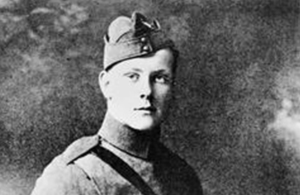WW1 Canadian VC recipient Alan Arnett McLeod
The story of Canadian First World War Victoria Cross recipient Alan Arnett McLeod.

Alan Arnett McLeod [© IWM (detail of Q 67601)]
70 men from Canada received the Victoria Cross, Britain’s highest award for gallantry, during the First World War. As part of the Centenary Commemorations the people of the United Kingdom marked their gratitude to those courageous men by presenting a bronze memorial plaque to their home country engraved with their names. The plaque is now displayed at the British High Commission Ottawa. This archive tells their stories.
Name: Alan Arnett McLeod
DOB: 20 April 1899
Place of Birth: Stonewall, Manitoba, Canada
Date of Action: 27 March 1918
Place of Action: Albert, France
Rank: 2nd Lieutenant
Regiment: Royal Flying Corps
Alan Arnett McLeod was born on 20 April 1899 in Stonewall, Canada. He successfully enlisted in the Royal Flying Corps in 1917 when he turned 18.
McLeod was a 2nd Lieutenant when he was awarded the Victoria Cross for his actions on 27 March 1918 in the skies above Albert in France. His citation states:
Whilst flying with his observer (Lt. A. W. Hammond, M.C.), attacking hostile formations by bombs and machine-gun fire, he was assailed at a height of 5,000 feet by eight enemy triplanes, which dived at him from all directions, firing from their front guns. By skilful manoeuvring he enabled his observer to fire bursts at each machine in turn, shooting three of them down out of control. By this time Lt. McLeod had received five wounds, and whilst continuing the engagement a bullet penetrated his petrol tank and set the machine on fire. He then climbed out on to the left bottom plane, controlling his machine from the side of the fuselage, and by side-slipping steeply kept the flames to one side, thus enabling the observer to continue firing until the ground was reached. The observer had been wounded six times when the machine crashed in “No Man’s Land,” and 2nd Lt. McLeod, not withstanding his own wounds, dragged him away from the burning wreckage at great personal risk from heavy machine-gun fire from the enemy’s lines. This very gallant pilot was again wounded by a bomb whilst engaged in this act of rescue, but he persevered until he had placed Lt. Hammond in comparative safety, before falling himself from exhaustion and loss of blood
McLeod returned home to Canada to recuperate from his wounds, but he died in November 1918. He is buried in Winnipeg, Manitoba.